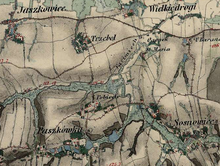Radwanite Corridor

The Radwanite Corridor ( Polish : Korytarz radwanicki ) is a historic landscape in southern Poland.
geography
The corridor was a strip of land mostly in the Pogórze Wielickie , about 9-10 kilometers wide between Jaśkowice on the Vistula in the north and Brody under the Central Beskids in the south. Approximately it comprised the present nine localities Brody, Zebrzydowice (without the hamlet Bieńkowice), Kalwaria Zebrzydowska , Bęczyn , Przytkowice , Sosnowice , Wielkie Drogi with the hamlet Trzebol , Jaśkowice, and Paszkówka with the hamlet Pobiedr.
history
The knightly Radwanita family may have come from Mazovia , but were probably settled in the wooded border area between the Duchy of Krakow and the Duchy of Opole between 1227 and 1243 due to the battle of Conrad I of Masovia for the Krakow Senior Duchy of Poland . The area between the rivers Skawa in the west and Skawinka in the east, however, was separated from Lesser Poland and Silesia on September 30, 1274 (incorrectly dated 1278) , without a group of villages owned by the Radwanite family loyal to the senior duke of Kraków, collectively called Trebol ( villas ac hereditates militum nostrorum te specialiter villas Raduanitarum Trebol vulgariter nuncupatas ). At the same time, the Radwanites (probably with their headquarters in Radwanowice , north of the Vistula ) received many privileges for hunting in forests and for founding new villages according to Polish and German rights.

The clustered villages Trzebol (as the oldest village) and Pobiedr (as the oldest parish in the middle of the area) were considered the most important centers of the corridor, but are no longer independent villages today.
The corridor made it difficult for the Upper Silesian dukes to consolidate their eastern territory and may have moved them to seek protection from the Bohemian king ( Mieszko von Teschen in 1291, Wladislaus von Auschwitz in 1327).
In the Middle Ages, it separated the main area of the Duchy of Auschwitz , after the division of the Duchy of Zator , from 1327 under feudal rule of the Kingdom of Bohemia , in the west from its small exclave in the east. The Radwanite Corridor was directly subordinate to the Kingdom of Poland. After 1274 the Radwanita family also took possession of some villages in the Duchy of Auschwitz (such as Brzeźnica , Brzezinka , Kopytówka , Marcyporęba and others). The border lost its importance in the second half of the 15th century, mainly when the Duchy of Zator was sold to the Polish king in 1494. The majority of the area belonged to the Szczyrzyc District within Poland, but the Silesia District, established in 1564, also included the village of Zebrzydowice, formerly on the southern edge of the corridor, and the town of Kalwaria Zebrzydowska, founded after 1600.
From 1975 to 1998 the area (excluding Jaśkowice and Wielkie Drogi) belonged to the Bielsko-Biała Voivodeship , which is why it was sometimes considered to be the northeastern edge of the Beskid foothills .
Individual evidence
- ↑ Tomasz Jurek (editor): WSTĘP ( pl ) In: Słownik Historyczno-Geograficzny Ziem Polskich w Średniowieczu. Edycja elektroniczna . PAN . 2010-2016. Retrieved April 22, 2019.
- ↑ a b Paweł Mostowik: Z dziejów Księstwa Oświęcimskiego i Zatorskiego XII-XVI w . Toruń 2005, ISBN 83-7441-175-9 , Aneks. Miejscowości ziemi oświęcimsko-zatorskiej, p. 60 (Polish).
literature
- Julian Zinkow: Wokół Kalwarii Zebrzydowskiej i Lanckorony . Wydawnictwo "CALVARIANUM", Kalwaria Zebrzydowska 2000, ISBN 83-8739541-2 , p. 96-99 (Polish).
- Kalwariarz . Towarzystwo Przyjaciół Kalwarii Zebrzydowskiej, ISSN 1899-8097 , p. 24–25 (Polish, online [PDF]).
Web links
- Full text of the document from September 30, 1274 (incorrect dating to 1278)
